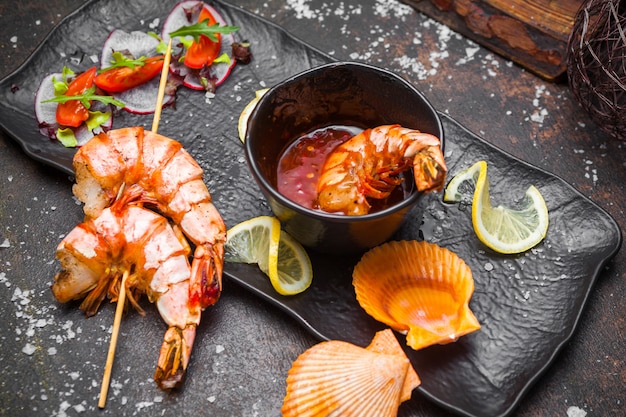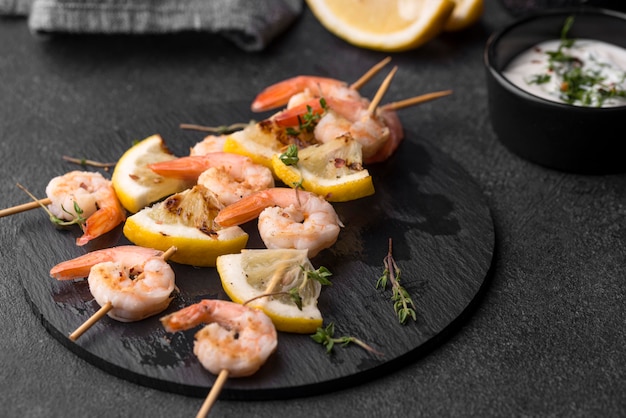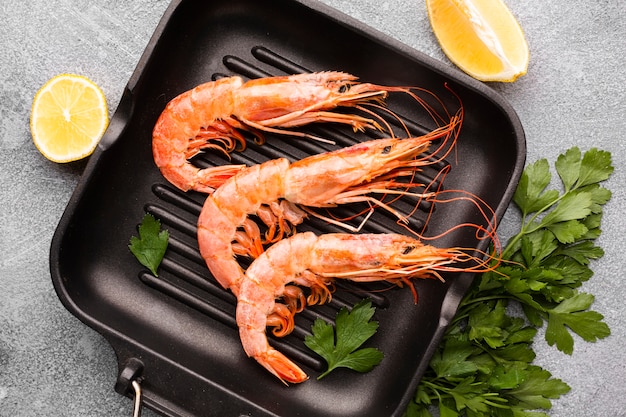Right, let's talk about cocktail shrimp. You know, those little guys that make every party feel a bit more fancy, a touch more celebratory. They're a classic for a reason. I've spent years mastering the art of cooking cocktail shrimp, trying out different methods, tweaking recipes, and learning from my (and others') mistakes. This guide is my attempt to share my hard-earned wisdom, my culinary secrets, if you will, to help you cook the most sensational cocktail shrimp you've ever tasted.
We'll start with the basics: choosing the right shrimp, prepping them, and understanding the different cooking methods. We'll delve into the world of sauces and dips, because let's face it, cocktail shrimp are all about the dipping experience. We'll even tackle the art of presentation, because a beautiful platter is just as important as the taste. We'll touch on some fun variations and explore how different cultures enjoy cocktail shrimp.
Get ready, because this is more than just a recipe. This is a journey into the heart of cocktail shrimp perfection. Let's dive in, shall we?
(Part 1) The Shrimp: Your Culinary Canvas

Choosing the Right Shrimp: A Guide to Quality
Alright, let's get down to the nitty-gritty. You want shrimp that are firm, plump, and have a nice bright colour. I've learned the hard way that limp, dull-looking shrimp are a recipe for disappointment. Look for shrimp labelled as "cocktail shrimp," which means they're already peeled and deveined. I'm a big fan of wild-caught shrimp, but farmed shrimp work just fine too. Remember, the most important thing is freshness.
When choosing, look for shrimp that are evenly sized. For cocktail shrimp, you're looking for small to medium shrimp. I prefer shrimp that are about 16-20 per pound. Shrimp in this size range tend to cook evenly and are perfect for bite-sized portions.
Size Matters: Finding the Perfect Fit
Here's a little tip: if you're not sure about the size, count the shrimp in a pound. If you see more than 20, they'll be on the smaller side, which is perfect for cocktail shrimp. If there are less than 15, you've got some hefty shrimp, which might be a bit too big for cocktail bites. You'll want to make sure your shrimp are manageable to eat in one or two bites, and the smaller sizes make it easier to maintain that classic cocktail shrimp feel.
Freezing Tips: Storing Your Shrimp Treasure
If you're buying frozen shrimp, make sure they're individually frozen. That way, you can easily grab just the amount you need. I often buy a big bag of frozen shrimp and keep them in my freezer for whenever the craving for cocktail shrimp strikes.
Don't thaw the frozen shrimp on the counter. It's a recipe for bacteria growth. Instead, pop them in the fridge overnight, or thaw them in a bowl of cold water for a couple of hours. Thawing in the fridge is the safest option, as it ensures a gradual and even thaw.
(Part 2) Prepping the Shrimp: A Quick and Easy Process

Okay, you've got your shrimp. Now it's time to get them ready for cooking. This part is pretty straightforward, but here are a few things to keep in mind:
The Peel-Off Process: A Necessary Step
You've already got peeled shrimp, right? Great! But just in case, remember to remove the shell. You don't want your guests to be surprised by a shell in their cocktail shrimp. It's all about making sure the eating experience is smooth and enjoyable.
Deveining: A Must-Do?
Now, about those "deveined" shrimp. Sometimes, there might be a tiny black vein that's left behind. You can remove it if you want to, but it's not absolutely necessary. Honestly, it's up to you and your preference. The vein itself is harmless, but it can be a bit unsightly. If you're a stickler for presentation, it's worth removing.
Rinse and Repeat: Washing Away Impurities
Rinse the shrimp thoroughly under cold water. You want to make sure they're clean and free of any debris. I've learned this the hard way, and trust me, it's not fun to bite into a piece of shell or a bit of grit. Rinsing removes any lingering bits of ice crystals from frozen shrimp, as well as any leftover residue from the packaging.
Pat Dry: The Final Touch
Pat the shrimp dry with paper towels. This helps to prevent them from steaming too much when you cook them, which can make them mushy. It's also a good idea to remove any excess water, which can dilute the flavor of your sauce. A dry surface ensures even cooking and prevents the shrimp from sticking to the pan.
(Part 3) Cooking Methods: From Pan to Pot

So, you've got your shrimp ready. Now comes the fun part – cooking! There are a few different ways to cook cocktail shrimp, and each method has its own unique characteristics. I've tried them all and have my favorites. Let's explore the options:
The Pan-Fried Method: A Quick and Delicious Option
This is my go-to method for cocktail shrimp. It's quick, easy, and results in shrimp that are beautifully cooked with a slight char. Pan-frying delivers a crisp texture and allows you to control the cooking time for perfect results.
- Heat a tablespoon of olive oil or butter in a skillet over medium-high heat. Use a good quality olive oil or unsalted butter for the best flavor.
- Add the shrimp and cook for 2-3 minutes per side, or until they turn pink and opaque. Shrimp are done when they're firm to the touch and no longer translucent.
- Season with salt and pepper to taste. A simple sprinkle of salt and pepper enhances the shrimp's natural flavor.
- Remove the shrimp from the skillet and set them aside. Let the shrimp rest for a few minutes to allow them to cool slightly and finish cooking.
The Steamed Method: A Subtle and Gentle Approach
If you want a more delicate flavour and texture, steaming is the way to go. It's a gentle cooking method that preserves the shrimp's natural sweetness. Steaming allows for a more delicate texture and lets the natural flavors shine.
- Bring a pot of water to a boil. Use a pot with a steamer basket that fits snugly.
- Add a steamer basket to the pot and place the shrimp in the basket. Don't overcrowd the basket to ensure even cooking.
- Cover the pot and steam for 2-3 minutes, or until the shrimp are cooked through. You'll know they're done when they turn pink and opaque.
- Remove the shrimp from the steamer basket and set them aside. Serve the shrimp immediately for the best results.
The Grilled Method: A Smoky and Savory Option
For a smoky and savory flavour, grilling is a great option. It's perfect for outdoor gatherings and adds a bit of rustic charm to your cocktail shrimp. Grilling imparts a wonderful smoky flavor and adds a touch of outdoor flair to your shrimp.
- Preheat your grill to medium heat. Ensure the grill is clean and lightly oiled to prevent sticking.
- Thread the shrimp onto skewers. Use wooden skewers that have been soaked in water for 30 minutes to prevent burning.
- Place the skewers on the grill and cook for 2-3 minutes per side, or until they turn pink and opaque. Flip the shrimp once to ensure even cooking.
- Remove the shrimp from the grill and set them aside. Remove the shrimp from the skewers and serve immediately.
(Part 4) Dipping Delights: A Symphony of Flavors
Okay, let's talk about the dipping sauces. It's a crucial part of the cocktail shrimp experience, so let's get it right.
The Classics: Tried and True
We've all got our favorites. There are a few classic sauces that are always a good choice:
- Cocktail Sauce: This is the traditional sauce, made with ketchup, horseradish, and lemon juice. You can find it pre-made, but it's easy to make your own. I love a bit of Worcestershire sauce and a dash of Tabasco to add a kick. Cocktail sauce is a classic for a reason, with a tangy and spicy flavor that complements the shrimp perfectly.
- Remoulade Sauce: This creamy and tangy sauce is a French classic. It's made with mayonnaise, mustard, chopped pickles, capers, and herbs. It's a great alternative to cocktail sauce and adds a sophisticated touch. Remoulade offers a more complex flavor profile, with a balance of tanginess, creaminess, and a hint of spice.
- Mignonette Sauce: This simple and refreshing sauce is made with vinegar, shallots, and black pepper. It's light and tangy and perfect for highlighting the shrimp's natural flavour. Mignonette is a perfect example of how simplicity can shine. Its delicate flavors let the shrimp take center stage.
Beyond the Basics: Explore and Experiment
But don't be afraid to get creative! There are so many other delicious sauces you can try. Here are a few of my favorites:
- Avocado Cream Sauce: This creamy and smooth sauce is made with avocado, sour cream, lime juice, and herbs. It's rich and decadent and pairs well with the shrimp's subtle sweetness. The avocado cream sauce is a great option for those who prefer a more luxurious and indulgent dipping experience.
- Spicy Mango Salsa: This vibrant and flavorful salsa is made with mango, red onion, jalapeno peppers, cilantro, and lime juice. It's a great way to add a touch of heat and freshness to your cocktail shrimp. Spicy mango salsa offers a burst of tropical flavor and a satisfying kick of heat.
- Lemon-Garlic Butter: This simple and flavorful sauce is made with butter, lemon juice, garlic, and parsley. It's easy to make and adds a burst of bright flavor to your shrimp. Lemon-garlic butter is a classic combination that works wonderfully with shrimp. It's simple to make and delivers a delicious combination of tangy and savory flavors.
(Part 5) Presentation Matters: A Feast for the Eyes
Presentation is key! A beautifully arranged platter can elevate your cocktail shrimp from a simple appetizer to a culinary masterpiece.
The Classic Platter: A Timeless Choice
Nothing beats a classic platter. Simply arrange the shrimp in a single layer on a platter or in a bowl. You can add a bed of ice to keep the shrimp chilled, which also adds a touch of elegance. Keeping the shrimp chilled is essential for preserving their texture and freshness.
Get Creative: Think Beyond the Ordinary
Let's have some fun, shall we? Here are a few ideas to make your cocktail shrimp platter stand out:
- Skewers: Thread the shrimp onto skewers and arrange them in a fan shape on the platter. Skewers make for a more visually appealing presentation and are easy for guests to grab.
- Miniature Bowls: Fill individual bowls or shot glasses with cocktail shrimp and arrange them on the platter. Miniature bowls add a touch of whimsy and make for a fun and interactive way to enjoy the shrimp.
- Decorative Garnish: Add a touch of color and flavor with garnishes like lemon slices, parsley sprigs, or edible flowers. Garnishes not only add visual appeal but also enhance the flavor and aroma of the shrimp.
Don't Forget the Dipping Sauce
Don't forget to add a variety of dipping sauces. You can present them in small bowls, ramekins, or even shot glasses. And don't forget to include spoons or toothpicks for dipping!
(Part 6) Cocktail Shrimp Party: A Celebration of Flavor
Alright, you're ready to host a cocktail shrimp party! Here are a few tips to make it a memorable event:
Timing is Key: Plan Ahead
Cocktail shrimp are best served fresh, so try to cook them just before serving. They can be kept chilled for a few hours, but they will start to lose their flavor and texture if they're left out for too long. I always aim to cook them within an hour of serving.
Chill Out: Keeping Your Shrimp Cool
If you're cooking a large batch, keep the shrimp chilled in an ice bath until ready to serve. This will help them stay fresh and delicious.
Don't Forget the Sides
Cocktail shrimp are a great appetizer, but they can also be part of a larger meal. You can serve them with crackers, bread, or chips. I like to serve them with a simple salad, or a light pasta dish.
The Drinks: The Perfect Pairing
You've got the shrimp, you've got the sauce, but don't forget the drinks! Cocktail shrimp are perfect with a chilled glass of white wine or a refreshing beer. A classic martini is also a good choice, or a simple glass of sparkling water.
(Part 7) Cocktail Shrimp Variations: Expanding Your Culinary Horizons
We've covered the basics, but there's so much more to explore! Let's talk about some exciting variations on the classic cocktail shrimp theme.
The Spicy Twist: Add a Kick to Your Shrimp
For those who like a bit of heat, you can add some spice to your cocktail shrimp. You can try adding chili flakes to the cooking water or the dipping sauce. I've even experimented with grilling shrimp with chipotle powder for a smoky, spicy flavor. Experiment with different types of chili flakes or peppers to find your perfect level of heat.
The Garlicky Goodness: A Flavorful Addition
Garlic adds a wonderful depth of flavor to shrimp. You can add minced garlic to the cooking oil or butter, or simply toss the cooked shrimp with garlic butter. Fresh garlic is best, but you can also use garlic powder if you're in a pinch.
The Citrus Infusion: A Refreshing Touch
Citrus fruits, like lemon, lime, and orange, add a bright and refreshing touch to cocktail shrimp. You can squeeze a bit of juice over the cooked shrimp, or add it to the dipping sauce.
The Herb Garden: A Fragrant Feast
Fresh herbs, like parsley, dill, chives, and basil, can elevate your cocktail shrimp to a whole new level. You can add them to the dipping sauce or simply garnish the finished shrimp. Fresh herbs add a burst of fragrance and flavor to your cocktail shrimp.
(Part 8) Cocktail Shrimp Around the World: A culinary adventure
Let's travel the globe with cocktail shrimp! It's a dish that's enjoyed all over the world, and each region has its own unique twists and variations. Here are a few examples:
Spanish Tapas: A Bite-Sized Delight
In Spain, cocktail shrimp are often served as tapas, small plates of appetizers. They're usually grilled with garlic and olive oil, and served with aioli, a creamy garlic sauce.
Asian Influences: A Fusion of Flavors
In Asia, cocktail shrimp are often served with spicy sauces, such as chili paste or sriracha. They're also frequently incorporated into stir-fries and noodle dishes.
Latin American Flavors: A Taste of the Tropics
In Latin America, cocktail shrimp are often served with aji verde, a green sauce made with cilantro, jalape??o peppers, and lime juice. They're also frequently grilled or fried with a variety of spices and herbs.
FAQs
What is the best way to store leftover cocktail shrimp?
Store leftover cocktail shrimp in an airtight container in the refrigerator for up to 3 days. They're best enjoyed within 24 hours for the best flavour and texture. Refrigerate the shrimp as soon as they've cooled down to ensure their freshness.
Can I freeze cooked cocktail shrimp?
Yes, you can freeze cooked cocktail shrimp. To freeze, place the shrimp in a freezer-safe bag or container and freeze for up to 3 months. Thaw them overnight in the refrigerator before serving. Freezing cooked shrimp is a great way to extend their shelf life and have them on hand for future meals.
What are some other dishes I can make with cocktail shrimp?
Cocktail shrimp can be used in a variety of dishes, such as salads, pastas, and rice bowls. You can also use them in sandwiches, wraps, or tacos. Cocktail shrimp are a versatile ingredient that can be added to a wide range of dishes.
What is the difference between cocktail shrimp and jumbo shrimp?
Cocktail shrimp are typically small to medium-sized shrimp, while jumbo shrimp are much larger. Cocktail shrimp are usually peeled and deveined, while jumbo shrimp are often sold in their shells. The size and preparation of the shrimp determine their suitability for different dishes.
How can I tell if shrimp is cooked?
Cooked shrimp will turn pink and opaque, and their flesh will be firm to the touch. The shrimp's internal temperature should reach 145°F (63°C). Properly cooked shrimp should have a firm texture and a slightly opaque appearance.
I hope this guide has inspired you to cook up a batch of perfect cocktail shrimp. So, gather your ingredients, get creative, and let your culinary imagination run wild! Happy cooking!
Everyone is watching

How to Cook Frozen Lobster Tails Perfectly: A Step-by-Step Guide
RecipesLobster. Just the word conjures up images of lavish meals, special occasions, and a taste of luxury. But let's...

Pigs in a Blanket Cooking Time: How Long to Bake for Perfect Results
RecipesAh, pigs in a blanket. Just the name conjures up images of those delightful little parcels of crispy pastry en...

Pork Fillet Cooking Time: How Long to Cook It Perfectly
RecipesPork fillet, or tenderloin as it's sometimes called, is a real favourite in our house. It's so versatile, and...

The Ultimate Guide to Cooking Sweet Potatoes: From Roasting to Mashing
RecipesSweet potatoes. Just the name conjures up images of warm, comforting dishes, bursts of vibrant color, and a to...

The Ultimate Guide to Tender, Juicy Pulled Pork
RecipesRight, let's talk pulled pork. It's one of those dishes that just screams "comfort food," doesn't it? I mean...
